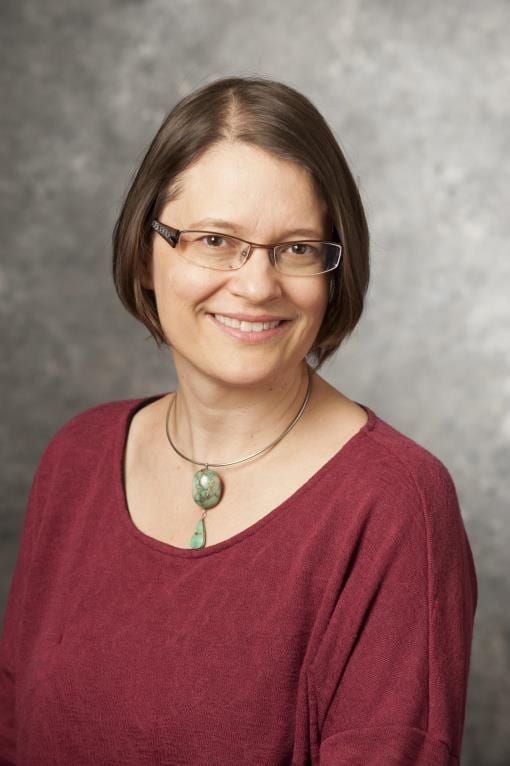Meet our Faculty Advisory Board Member, Elizabeth Russ, Associate Professor of Spanish and Chair, World Languages and Literature at SMU, and learn more about her work.

You are the Chair of World Languages and Literatures at SMU. Can you tell us about your role?
I lead the largest department at SMU, with more than 50 faculty members who teach 11 different languages, including Arabic, ASL, Chinese, French, German, Ancient Greek, Italian, Japanese, Latin, Russian, and Spanish. As you can imagine, they are a dynamic group of scholars and teachers who come from many different places but unite around a common mission. My job is to support them and help them grow successful, thriving programs. Almost every SMU student passes through our classrooms to satisfy the second language requirement, and many stick around long enough to major or minor in a language. Currently, we have more than 400 undergraduates completing degrees in our department. So many universities have slashed language teaching in recent years, but SMU recognizes that, if we really want to shape world changers, we need to graduate students who are able to engage the world with knowledge and sophistication, and studying different languages and cultures is one of the best ways to be able to do that.
Did studying literature get you interested in learning Spanish or vice versa?
It was my love of literature that inspired me to learn Spanish. In high school, I studied French, but it never really clicked for me. Then I discovered some of the writers of the so-called “boom” in Latin American literature—like Gabriel García Márquez, Mario Vargas Llosa, and Carlos Fuentes—and I decided I wanted to be able to read the original versions of their books, not just translations. I began with first-semester Spanish my freshman year of college and spent six months studying abroad in Santiago de Chile my junior year. After graduation, I taught bilingual kindergarten for two years in Dallas ISD. Of course, since I was starting from scratch, it took me MANY years to get to the point where I could actually read and understand the writers that first inspired me, but the journey was a lot of fun!
At SMU, you teach a class about Dallas and one examining the long history between Mexico and the United States, with a focus on Texas. Why do you feel it’s important for students to learn about the history of Mexicans in Texas and their local impact?
It’s funny. My published research focuses on the Spanish-speaking Caribbean, especially the Dominican Republic, which is a far cry from Texas. But during my first years teaching at SMU, I came to believe we needed to offer more content in the Spanish program about the U.S.-Mexico relationship because it is just such a critical, but sometimes almost invisible, part of our everyday life here in Dallas and across Texas. At the same time, broader debates about immigration and the border kept appearing and reappearing in the media, so I thought it was important for our students to understand those debates in the context of a long and complex history. At first, I just created a few short units on the topic. Eventually, I developed a whole course, which finally spun off into the English-language version of the Texas-Mexico class I currently teach, which combines history, politics, and economics with literature and film to give students a broad understanding of what is a dynamic, nuanced, and fascinating relationship.
The class on Dallas, which I have team taught with David Doyle (History), Caroline Brettell (Anthropology), and Lucas Kirkpatrick (Sociology), is also interdisciplinary. Teaching it has given me the opportunity to do a deep dive into the fascinating and understudied history and culture of the Mexican and Mexican-American communities in our own community. I grew up in Dallas, and never learned anything about these topics, so it’s been a privilege and pleasure to educate myself and my students.
One of the best parts of both the Texas-Mexico and the Dallas class is that we get to take students on tours of the city, to explore on the ground the places where important events took place, as well as where the city is changing and evolving right now.
Why did you decide to become a Faculty Advisory Board Member of the Texas-Mexico Center?
I was honored to be asked to join the Faculty Advisory Board of the Texas-Mexico Center! I am passionate about its mission to understand and explore the dynamic political, cultural, economic, and business relationship between Texas and Mexico, and I love to look for opportunities to connect my department’s Spanish program with the Center’s many activities and initiatives. Of course, I also appreciate that being on the board has given me so many opportunities to meet and talk to true experts on Texas and Mexico, and to deepen my own knowledge about those aspects of the Texas-Mexico relationship that fall out of my own academic expertise in the realm of cultural production.

0 comments on “Faculty Advisory Board Profile: Elizabeth Russ” Add yours →